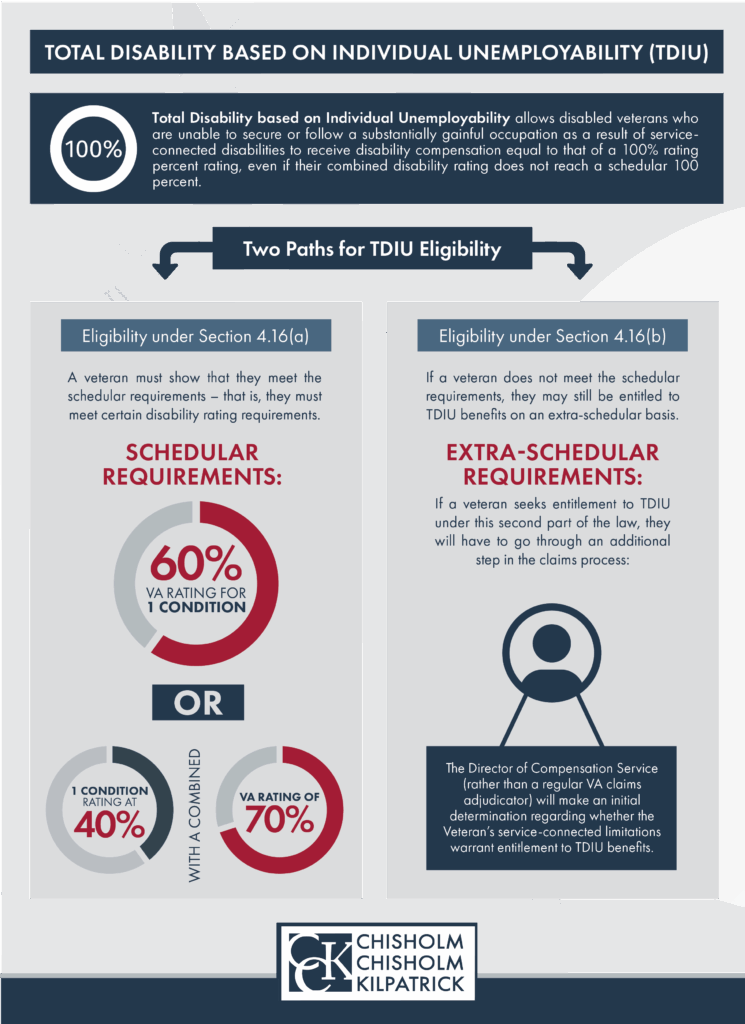50% VA Disability Rating, Benefits, and Pay

CCK Law: Our Vital Role in Veterans Law
If VA has assigned your service-connected disability a 50 percent VA disability rating, you now qualify for a variety of disability benefits. These include monthly compensation benefits, VA health care benefits, employment benefits, and more.
In this article, you will learn about each of the benefits awarded with a 50 percent VA disability rating, as well as strategies you can use to increase your rating and earn higher payments from VA.
Highlights of this article include:
- The payments rates and extra compensation a 50 percent VA disability rating can qualify you for
- Additional benefits available for 50 percent disabled veterans
- The process for increasing your VA rating
- And more
What Is a VA Disability Rating?
A disability rating is percentage assigned by the Department of Veterans Affairs to a veteran’s service-connected condition. VA disability ratings, which range from 0 to 100 percent, are based on the frequency, duration, and severity of symptoms. Essentially, the higher the percentage, the more severe the service-connected disability.
If a veteran has multiple service-connected conditions, VA will combine the individual disability ratings using VA math to get a combined disability rating. This combined disability rating will then determine the veteran’s monthly benefit amount. Veterans must have a combined disability rating of at least 10 percent to qualify for VA monthly compensation.
50 Percent Veterans Disability Compensation Rates
As of 2025, the VA disability rate benefit amounts are as follows:
- 0 percent disability rating: $0.00 per month
- 10 percent disability rating: $175.51 per month
- 20 percent disability rating: $346.95 per month
- 30 percent disability rating: $537.42 per month
- 40 percent disability rating: $774.16 per month
- 50 percent disability rating: $1,102.04 per month
- 60 percent disability rating: $1,395.93 per month
- 70 percent disability rating: $1,759.19 per month
- 80 percent disability rating: $2,044.89 per month
- 90 percent disability rating: $2,297.96 per month
- 100 percent disability rating: $3,831.30 per month
Note that the exact amount of compensation may increase or decrease each year depending on the cost-of-living adjustment (COLA). This adjustment ensures benefits keep up with inflation.
Additional Compensation for Dependents
Veterans with a combined disability rating of 30 percent or higher and one or more qualifying dependents are eligible for additional monthly compensation for each dependent.
Qualifying dependents include:
- A spouse
- Dependent parents
- Dependent Children under the age of 18
- Dependent Children between the age of 18 and 23 who are in school (must be unmarried)
- Children who were severely disabled prior to reaching the age of 18
The amount of additional compensation depends on a veteran’s disability rating and their claimed dependents.
Additional 50 Percent VA Disability Benefits
In addition to monthly VA compensation, veterans with a 50 percent disability rating may also be eligible for the following VA benefits:
VA Health Care Benefits for 50 Percent Disabled Veterans
VA uses priority groups to categorize veterans and the different types of health care benefits they receive. There are eight priority groups, and each group has a different copay.
To be placed in VA Health Care Priority Group 1, the highest priority group, veterans need to be service connected at 50 percent or more.
Veterans in Priority Group 1 are eligible to receive all their health care services through VA with no copays. Some of these services include:
- Preventive care
- Inpatient (hospitalization) services
- Ancillary services
- Mental health care
- Geriatrics and extended care
- Medical equipment/prosthetic items and aids
- Medication/supplies
- Nursing home placement
- Eyeglasses
- Hearing aids
- Automotive adaptive equipment (under certain conditions)
- Home improvement and structural alteration grants (under certain conditions)
- Clothing allowance benefits (under certain conditions)
- Dependents’ health care (if not eligible under TRICARE)
- Emergency care at a non-VA facility (under certain conditions)
- Foreign medical care (for service-connected and secondary conditions)

Vocational Readiness and Employment (VR&E)
If you have a 50 percent disability rating, you may also be eligible for Vocational Readiness and Employment (VR&E) benefits from VA.
VR&E provides a range of career services, including career counseling and rehabilitation planning for employment; job training, job-seeking skills, résumé development, and other work-readiness assistance; and on-the-job training, apprenticeships, and non-paid work experience.
VA Home Loan Guarantee
VA offers a home loan guarantee to help eligible veterans buy, repair, rebuild, or keep a home. Typically, VA will guarantee a home loan provided by a private lender (i.e., banks and mortgage companies) to ensure the veteran receives more favorable terms on their mortgage. Through this guarantee, veterans can qualify for lower interest rates and lower down payments for their home.
Free Tax Preparation Services
The IRS’s Volunteer Income Tax Assistance (VITA) and Tax Counseling for the Elderly (TCE) programs assist thousands of veterans with preparing their taxes for free every year.
The IRS works with local community groups to train and certify VITA and TCE volunteers. These volunteers then help qualifying disabled veterans prepare their taxes. VITA and TCE also provide free electronic filing.
Life Insurance for Disabled Veterans
Veterans’ Group Life Insurance (VGLI) is a benefit that offers low-cost insurance to eligible veterans. Veterans can receive between $10,000 and $500,000 in life insurance benefits. The exact amount is usually based on the amount of Servicemembers’ Group Life Insurance (SGLI) coverage they had when they left the military.
Federal Hiring Preference
Disabled veterans who meet eligibility requirements can receive hiring preference when applying to certain federal positions. This preference adds extra points to their civil service exam or application score, often placing them ahead of non-veteran candidates in the selection process.
Travel Allowance for Disabled Veterans
For veterans seeking care at a VA hospital or VA-approved care at a non-VA facility, VA may reimburse you for travel expenses you incur getting to your appointment. These reimbursements cover many typical modes of travel, including train, plane, car, and taxi, as well as certain meal and lodging expenses.
Training Programs Under the Post 9/11 GI Bill
Eligible veterans may qualify for programs under the Post 9/11 GI Bill. These programs include, but are not limited to, the following:
- Entrepreneurship training
- Flight training
- Institutions of higher learning (i.e., undergraduate and graduate degrees)
- Licensing and certification reimbursement
- On-the-job training
- Tutorial assistance
- Vocational/technical training
Concurrent Retired and Disability Pay
Veterans with a disability rating of 50 percent or higher may qualify for Concurrent Retired and Disability Pay (CRDP). This benefit restores veterans’ service pay by eliminating the VA waiver (i.e., the amount the veteran receives in VA disability compensation subtracted from the amount they receive in retired pay to avoid “double-dipping.”)
State Benefits for 50 Percent Disabled Veterans
Alongside each of these other benefits, veterans holding a 50 percent disability rating may be eligible for additional benefits offered by their state. These can include perks like complimentary access to state parks, hunting and fishing permits, and exemptions on property taxes.

50 Percent VA Disability and Social Security
Veterans with a 50 percent disability rating may also qualify for some amount of Social Security income. There are two different types of Social Security benefits: Social Security Disability Insurance (SSDI) and Supplemental Security Income (SSI).
SSDI only counts earned income; therefore, VA disability benefits have no effect on entitlement to SSDI. However, it is important to note that veterans must have a totally disabling condition to be eligible for SSDI.
SSI, on the other hand, is need-based and any contribution from VA disability compensation will count towards a veteran’s income. The income limit for SSI for 2025 is $967 per month. Since veterans with a 50 percent disability rating receive $1,102.04 per month from VA, they are most likely not eligible for SSI.
How to Increase a 50 Percent VA Disability Rating
If you are dissatisfied with your 50 percent disability benefits and want to attempt to increase your overall VA rating, you have several options available:
- File an appeal: If a veteran disagrees with VA regarding the rating they were assigned, they have up to one year from the date of VA’s initial decision to challenge the outcome by submitting an appeal. There are three available appeal options, or “lanes”: (1) Request a Higher-Level Review, (2) Submit a Supplemental Claim, or (3) File a Notice of Disagreement with the Board of Veterans’ Appeals.
- Request a higher rating: If a veteran believes their service-connected condition has become more severe, they can file a claim seeking an increased disability rating.
- Apply for secondary service connection: If a new medical condition has developed as a direct result of an existing service-connected disability, veterans can also file for secondary service connection. This may raise their combined disability rating.
- Hire a VA-accredited attorney: An experienced advocate will be able to identify gaps in your evidence, additional or secondary conditions, or other benefits for which you are eligible.
- If you are unable to work, you may also want to consider extraschedular TDIU. See next section.

50 Percent VA Disability and Extraschedular TDIU
Total Disability based on Individual Unemployability, or TDIU, compensates veterans who are unable to work due to their service-connected condition(s) at the 100 percent disability rating level, even if they do not have a totally disabling condition. To qualify for TDIU, veterans must prove they cannot obtain or maintain substantially gainful employment.

Although veterans with a 50 percent combined rating cannot qualify for TDIU on a schedular basis due to the percentage requirements, they may be able to qualify on an extraschedular basis. VA regulation 38 CFR § 4.16(b) states that VA should refer the veteran’s TDIU claim Director of Compensation Service for extraschedular consideration.
The Director will then review factors such as the veteran’s service-connected conditions, employment history, and educational and vocational attainment to determine if TDIU is warranted.
Were You Underrated by VA?
Whether your VA disability claim was denied or you are looking to secure a higher rating, Chisholm Chisholm & Kilpatrick LTD may be able to assist.
The experienced attorneys and accredited claims agents at CCK Law have spent decades advocating for veterans and helping them obtain the benefits that they have earned through service and sacrifice.
Call CCK Law today at (800) 544-9144 or contact us online for a free case evaluation!
About the Author
Share this Post
